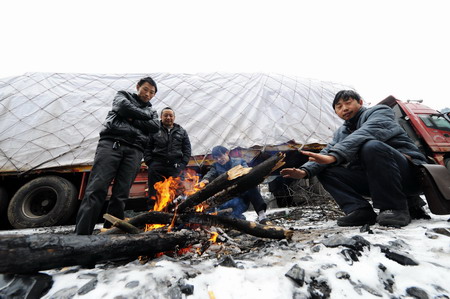China
Stranded passengers endure cold
By Yan Jieand Guo Rui (China Daily)
Updated: 2011-01-05 08:22
 |
Large Medium Small |
|
 Four drivers stranded on a section of the No 319 National Highway in Huaihua city of Hunan province nurse a fire to warm themselves on Tuesday. Long Hongtao / Xinhua |
HUAIHUA, Hunan - Parts of Central and South China on Tuesday braced for the fourth straight day of freezing rains that disrupted highway operations and left thousands of passengers still stranded.
As of Tuesday morning, 20 sections of four national highways and 10 provincial highways in Central China's Hunan province were still closed due to thick ice on the road, He Dingguang, with the provincial highway management administration, said.
Ice and snow were reported in several sections of 23 operating expressways in the province but inflicted no major traffic disruptions except in the Huaihua-Xinhuang section of the Shanghai-Kunming highway.
That section was clogged because of traffic accidents and frozen road surfaces, leaving about 275 vehicles and nearly 900 passengers stranded, according to the provincial highway management administration.
In addition, nearly 400 vehicles and about 1,600 passengers still lingered in the service stops in two other sections of the Shanghai-Kunming highway.
"What I'm worried about most is the ice still on the road surface, which can easily cause a chain of traffic accidents," said Li Yongjin, a traffic police official at the public security bureau of Huaihua city.
He said all traffic policemen in the bureau have cancelled their holidays and have been on duty at various sections of frozen highways and roads.
More than 10,000 people also spent their three-day New Year's Day holiday clearing ice-coated highways in Hunan as part of several emergency plans, according to the provincial highway management administration.
Li said the traffic control measures in Guizhou province, which was also severely hit by sleet, have caused neighboring Xinhuang county in Hunan and Nandan county in the Guangxi Zhuang autonomous region to experience the highest number of stranded vehicles and passengers.
But he said traffic authorities have drawn on their experiences from 2008 to divert stranded vehicles and prepare emergency supplies to avert panic.
Huaihua has prepared 2,000 tons of food and hundreds of camp beds to help the stranded, as well as 81 tons of salt to melt the ice.
"This was unimaginable in the past," Li said.
He said one of the traffic police's major tasks is to convince stranded drivers to detour to other roads instead of staying on the highways.
Figures from the public security bureau in Huaihua show that by Tuesday evening a total of 4,754 vehicles had been evacuated.
However, some drivers are reluctant to take detours. A driver surnamed Wang in Sanhui county of the neighboring Guizhou province said he was used to driving on the highways, and it was inconvenient and made him feel unsafe to take other roads where conditions were not as good as the highways.
In Guizhou and Guangxi, many icy highways have resumed operations as clearance work kicked in on Tuesday, but local highway authorities are still on guard.
Nandan county in Guangxi prepared 2.7 million yuan ($408,700) worth of instant noodles, bottled water, winter clothes and quilts, the county's Party chief Xu Qinheng said.
Four ambulances and 200 policemen are standing by in case of emergencies in the county, he added.
The National Meteorological Center predicted on Tuesday that the temperature will remain below 0 C in areas affected by freezing rains in Guizhou and Hunan provinces and in Chongqing municipality as of Jan 5.
The Ministry of Transport also held an emergency meeting on Tuesday. Li Shenglin, minister of transport, urged local transport authorities to avoid or reduce closings of expressways and stockpile sufficient emergency materials for the icy weather.
2008's freeze unlikely to reoccur
The latest freezing rains in Guizhou, Guangxi and Hunan have reminded people of the icy havoc in South China two years ago.
In early 2008, about 100,000 people were stranded on the Beijing-Zhuhai expressway as unprecedented snow and ice coated roads in South China. The ice also caused massive damage to the power grid, bringing down towers and wires.
Ren Fumin, a researcher at the China Meteorological Administration (CMA), said the current atmospheric circulation in China is very different from that in early 2008.
"However, the La Nina weather pattern will gradually increase this month and periodic extreme cold weather conditions are still possible this winter," he was quoted by the China News Service as saying.
Chen Zhenlin, director of the disaster relief and public service department of the CMA, also said it's quite unlikely for the country to see a disaster similar to the one in 2008. But authorities should get prepared for low temperatures in January by storing enough coal to generate power and turning on the de-icing facilities for power lines in time.
Hu Yongqi and Xinhua contributed to this story.
China Daily